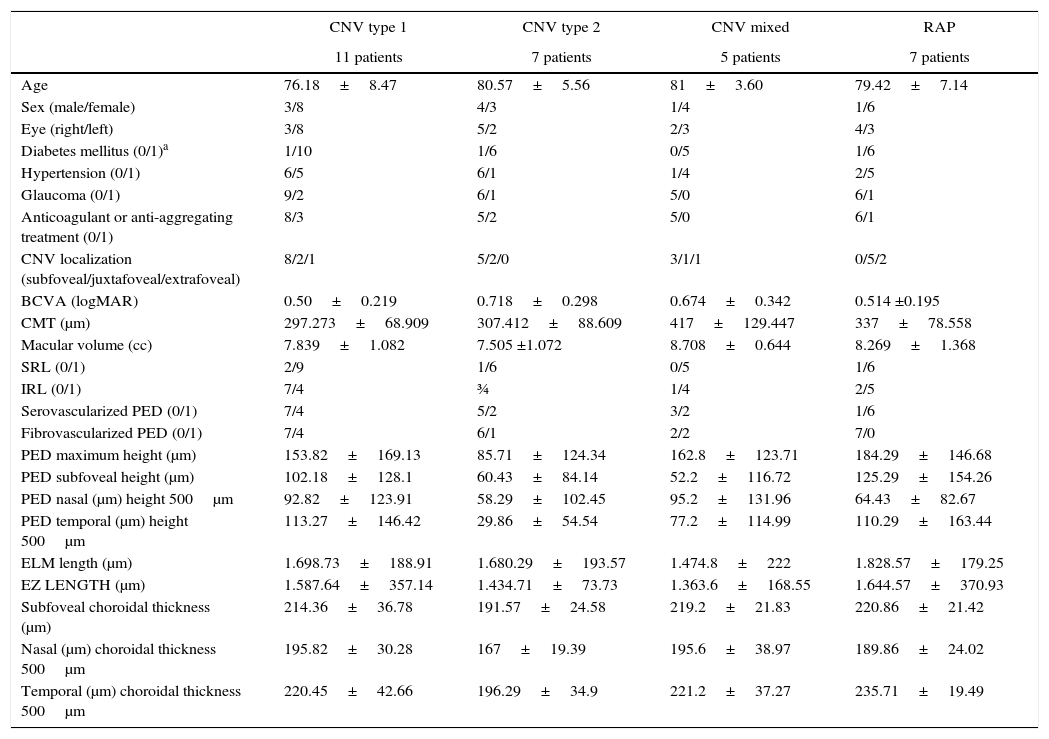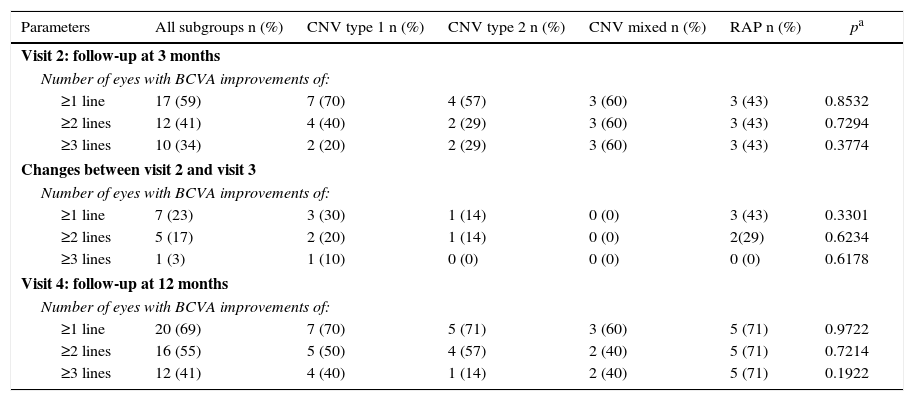To describe functional/morphological outcomes of treat-and-extend (TAE) with aflibercept in different subtypes of neovascularizations (CNV) secondary to exudative age-related macular degeneration (AMD).
MethodsRetrospective study was conducted on 30 eyes of 30 patients treated with 2mg-aflibercept according to a TAE protocol. Examinations included best corrected visual acuity (BCVA), number of injections, and visits needed. A quantitative/qualitative analysis was also performed with fluorescein angiography and spectral-domain optical coherence tomography (SD-OCT) at baseline, and at 3, 6, and 12 months.
ResultsBCVA significantly improved from 0.61±0.26 logMAR to 0.38±0.34 logMAR. Among the total AMD patients, type 1 CNV was diagnosed in 11 eyes (36%), type 2 CNV in 7 eyes (23%), mixed CNV in 5 eyes (16%), and type 3 CNV or retinal angiomatous proliferation (RAP) in 7 eyes (23%). The final mean number of injections was 7.5±1.65, 8.71±0.76, 7.4±0.89, 7.2±0.7, and number of visits 6.6±2.17, 7.89±1.46, 5.8±1.7, and 7.14±1.57, respectively in type 1, type 2, mixed, and type 3 or RAP. There was no difference between the different subtypes of CNV (P>0.05).
ConclusionsAflibercept in TAE is effective for all exudative-AMD subtypes. No significant differences in patient's visual gain, mean number of injections, or number of visits needed were found among the subtypes of CNV.
Describir los resultados funcionales/morfológicos del tratamiento con aflibercept en régimen del tipo tratar y extender (TE) en los diferentes tipos de neovascularizaciones (NVC) secundarias a la degeneración macular exudativa asociada a la edad (DMAE).
MétodosEstudio retrospectivo en 30 ojos de 30 pacientes tratados con 2mg de aflibercept de acuerdo con un protocolo TE. Dentro de los parámetros analizados se incluyen la mejor agudeza visual corregida (MAVC) y el número de inyecciones y de visitas necesitado. Además, se incluyen los resultados de un análisis cuantitativo y cualitativo con angiofluoresceingrafía y tomografía de coherencia óptica de dominio espectral (SDOCT) al inicio y a los 3, 6 y 12 meses de seguimiento.
ResultadosDe entre los pacientes con DMAE analizados, el componente de NVC de tipo 1 se encontró en 11 ojos (36%), el tipo 2 en 7 ojos (23%), el mixto en 5 ojos (16%) y el componente tipo 3 o proliferación angiomatosa retiniana (RAP), en 7 ojos (23%). La MAVC mejora significativamente de 0,61±0,26 logMAR a 0,38±0,34 logMAR. El número medio final de inyecciones fue de 7,5±1,65; 8,71±0,76; 7,4±0,89 y 7,2±0,7, y el de visitas de 6,6±2,17; 7,89±1,46; 5,8±1,7 y 7,14±1,57 respectivamente en membranas de tipo 1, de tipo 2, mixtas y de tipo 3 o RAP, que no difiere según el subtipo de NVC (p>0,05).
ConclusionesAflibercept en pauta TE constituye un tratamiento eficaz en todos los tipos de NVC asociadas a DMAE. No se han observado diferencias significativas en ganancia visual, en el número medio de inyecciones ni en el número medio de visitas en función del subtipo de NVC.
Artículo
Comprando el artículo el PDF del mismo podrá ser descargado
Precio 19,34 €
Comprar ahora











